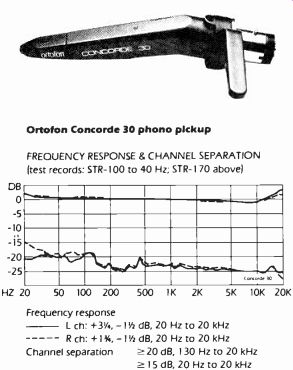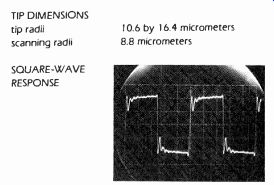A Low-Mass Beauty
--------------
FREQUENCY RESPONSE / CHANNEL SEPARATION (test records: STR-100 to 40 Hz; STR-170 above)
HZ 20 50 100 200 500 1K 2K 5K 10K
Frequency response L ch: +3%,-11/2 dB, 20 Hz to 20 kHz R ch: +14A,-11/2 dB, 20 Hz to 20 kHz
Channel separation 20 dB, 130 Hz to 20 kHz 15 dB, 20 Hz to 20 kHz 20K
SENSITIVITY (at I kHz) 1.12 mV/cm/sec
CHANNEL BALANCE (at 1 kHz) ± dB
VERTICAL TRACKING ANGLE 25 ½ degrees.
LOW-FREQUENCY RESONANCE (in SME 3009 arm) vertical 10.5 Hz; 6 1/4-dB rise lateral 10 Hz; 744-dB rise
MAXIMUM TRACKING LEVEL (re RIAA 0 VU; 1.2 grams) at 300 Hz +18dB at 1 kHz +12 dB
TIP DIMENSIONS
tip radii 10.6 by 16.4 micrometers
scanning radii 8.8 micrometers
-----------------

Ortofon Concorde 30 fixed-coil phono pickup in universal headshell, with multi-radial diamond stylus.
Price: $165; CL-30 replacement stylus, S90. Warranty: "limited," one year parts and labor.
Manufacturer: Ortofon, Denmark; U.S. distributor: Tannoy-Ortofon, Inc., 122 Dupont St., Plainview, N.Y. 11803.
The integrated pickup headshell, based on the so-called universal headshell-tonearm coupling that recently has grown so rapidly in popularity, is one of those good, practical ideas whose time has finally arrived. An obvious convenience and time-saver (losing tiny mounting screws can be a giant headache), the format also enables manufacturers to engineer a single, low-mass ensemble for arm designs that otherwise tend to be rather massive for today's pickups. Ortofon's Concorde 30-so named because of its resemblance to the supersonic airliner with the down-turned nose-manages to pare total mass to just 6.3 grams, about that of many pickups alone. Also important in the Concorde's design is the use of a fine-line, nude-mounted diamond tip whose multi-radial geometry and direct mounting without a "setting" contribute to what Ortofon claims is the lowest effective stylus tip mass available.
As expected from such a cartridge, tracking ability is exceptional. CBS found it capable of navigating the "torture" test with just 3/4 gram of vertical tracking force. A VTF of 1.2 grams (the minimum value recommended by Ortofon) was used for the balance of the testing, with the recommended load of 47,000 ohms shunted by 400 picofarads. Channel separation proved very good; frequency response with this load is in line with that of other top-notch pickups. There is a slight dip followed by a moderate peak as the test frequency approaches 20 kHz with the STR-170, but listening tests could not fault the Concorde's high-frequency behavior on music. The output level is ample for typical phono stages, though the channel balance (at 1 kHz) in the bench-test sample was a hair less exact than average among current top models. And both harmonic and intermodulation distortion are acceptably low.
Examining the results of the Concorde's behavior in the low-frequency resonance test discloses the chief virtue of a low-mass design. With the cartridge mounted in our "standard" SME arm, the vertical and lateral resonance are firmly in "ideal" territory-as far removed as practical from the region where warp information may be transmitted to the amplifier circuitry. Since so light a pickup may be beyond the balance adjustment range of some arms, each Concorde comes with a low-mass counterweight with a center-hole diameter of 15 millimeters. Ortofon offers to exchange this one for alternatives with 12- or 18-millimeter openings, should the lighter weight prove necessary and the dimensions of the version provided be inappropriate for your arm. (To save yourself the bother of writing directly to Ortofon, you might check the dimensions with your dealer in advance of purchase. Ortofon informs us that its dealers should have a varied supply of counterweights in stock.) In use, the Concorde acquitted itself with good marks all around. It managed to track some of the worst warps we have, and its distinctive down-turned nose actually contributes to this by raising the cartridge body over some of the steepest warps, while the narrowness of the nose minimizes the chance of hang-up on the edge bead of severely warped discs. We are at a loss to describe its tone since it introduces no characteristic color of its own to the music we heard.
Detailing on even the most complex passages emerges with clarity and definition.
This, combined with its installation convenience and its sleek physical beauty, make it among the most attractive pickups around.

-------- SQUARE-WAVE RESPONSE
Ad for Ortofon (Jan. 1980)

Launching a new era--in the reproduction of music from records.
A strong claim, but true. The Concorde combines a cartridge and headshell in a single form, but weighs less than most head-shells alone. The reduction in record wear anal distortion, and the ability to track accurately despite warpage, pay incalculable dividends to music lovers.
Ortofon dealers are now ready to demonstrate the Concorde. It's worth a visit just to see and hear this remarkable cartridge that stands at the very frontier of music reproduction technology. For complete information write: Ortofon, 122 Dupont Street, Plainview, New York 11803.
Ortofon
(High Fidelity, Jan. 1980)
Also see:
SAE Two Model R-6 stereo FM/AM receiver (review, Jan. 1980)